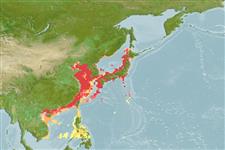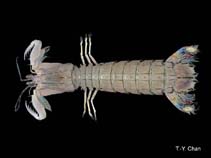Oratosquilla oratoria (De Haan, 1844)
Japanese squillid mantis shrimp| Native range | All suitable habitat | Point map | Year 2050 |

|
| This map was computer-generated and has not yet been reviewed. |
| Oratosquilla oratoria AquaMaps Data sources: GBIF OBIS |
Classification / Names Common names | Synonyms | CoL | ITIS | WoRMS
Malacostraca | Stomatopoda | Squillidae
Environment: milieu / climate zone / depth range / distribution range Ecology
Benthic; brackish; depth range 10 - 100 m (Ref. 3099). Subtropical; 46°N - 10°N, 106°E - 144°E
Distribution Countries | FAO areas | Ecosystems | Occurrences | Introductions
Western Pacific: from Vietnam to northern Japan, south to Bohol, Philippines. Introduced to Australia and New Zealand.
Length at first maturity / Size / Weight / Age
Maturity: Lm 9.6 range ? - ? cm Max length : 18.5 cm TL male/unsexed; (Ref. 3099)
Maximum depth from Ref. 80410. Demersal (Ref. 105264). Burrows in near-shore level-bottom substrates (Ref. 92) in sheltered embayment or estuaries (Ref. 3099). Occurs in muddy bottoms of bays and inlets (Ref. 105263). Feeds mainly on crustaceans, mollusks, polychaetes, and fish; occasionally on plant materials (Ref. 105093).
Life cycle and mating behavior Maturity | Reproduction | Spawning | Eggs | Fecundity | Larvae
Some members of the order Stomatopoda pair for life and some come together only to mate. Males produce sperm ducts rather than spermatophores; females can brood a maximum of 50,000 eggs. Life cycle: Eggs hatch to a planktonic zoea which lasts for 3 months.
Main reference
References | Coordinator | Collaborators
Manning, R.B. 1998. (Ref. 92)
IUCN Red List Status (Ref. 130435)
CITES status (Ref. 108899)
Not Evaluated
CMS (Ref. 116361)
Not Evaluated
Threat to humans
Harmless
Human uses
Fisheries: commercial
| FishSource | Sea Around Us
Tools
More information
Internet sources
BHL | BOLD Systems | CISTI | DiscoverLife | FAO(Publication : search) | Fishipedia | GenBank (genome, nucleotide) | GloBI | Gomexsi | Google Books | Google Scholar | Google | PubMed | Tree of Life | Wikipedia (Go, Search) | Zoological Record
Estimates based on models
Preferred temperature
(Ref. 115969): 9.7 - 25.3, mean 15.8 (based on 374 cells).
Resilience
(Ref. 69278):
High, minimum population doubling time less than 15 months (K=0.72-0.82).
Nutrients: Calcium = 109 [35, 184] mg/100g; Iron = 1.59 [1.21, 1.97] mg/100g; Protein = 20.2 [19.2, 21.3] %; Omega3 = 0.285 [0.185, 0.386] g/100g; Selenium = 48.3 [-31.7, 128.3] μg/100g; VitaminA = 0 μg/100g; Zinc = 1.79 [1.17, 2.40] mg/100g (wet weight).



